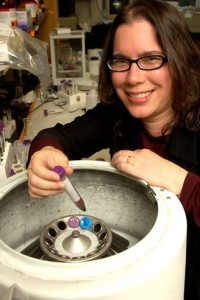 Atomic element #79 is the precious metal more commonly known as gold.
Atomic element #79 is the precious metal more commonly known as gold.
Catherine Murphy, a chemist at The University of Illinois at Urbana-Champaign, is working with gold on a nanoscale level and showing its usage far beyond the creation of jewelry.
Catherine J Murphy is the Peter C and Gretchen Miller Markunas Professor of Chemistry at the University of Illinois at Urbana-Champaign. Dr. Murphy was born in New Jersey but grew up in the suburbs of Chicago. Professor Murphy earned two BS degrees, one in chemistry and one in biochemistry, from UIUC in 1986. She was awarded her PhD from the University of Wisconsin, Madison in 1990. After a postdoctoral fellowship at the California Institute of Technology, she began her independent academic career in the Department of Chemistry and Biochemistry at the University of South Carolina in 1993. In 2009, she moved back home to Illinois. Her husband teaches calculus in the math department at UIUC.
Gold Nanotechnology
![]()
Nanotechnology is the study of matter on the 1-100 nanometer scale – about ten to a thousand atoms across. Many elements in the periodic table are metals, and chemists like me are figuring out ways to create tiny metal nanoparticles of different shapes and sizes – spheres, cylinders, stars, you name it. We focus on gold. The cool thing is that each shape and size of gold nanoparticle absorbs and scatters light at different wavelengths, so each size and shape has a different color. So all the colors of the rainbow, and then some, are possible with gold nanoparticles.
The reasons for these neat colors go back to understanding the fundamental nature of light. We know from Maxwell’s equations that light is an electromagnetic wave. If light impinges on a “small conducting sphere,” then there are conditions under which certain wavelengths of light lead to huge oscillations in the electron cloud around the metal, for any metal in the periodic table, as a function of the size of the sphere, the dielectric constant of the metal, and the refractive index of the medium. These equations were worked out by Gustav Mie in the early 1900’s and give us a fundamental understanding of where these brilliant colors come from. In the last 30 years, scientists have adapted his equation for all kinds of shapes beyond spheres.
But gold nanoparticles are not just pretty to look at: they can do a lot of interesting things. For instance, these gold nanoparticles also scatter light, making them easy to find in a simple optical microscope; and since gold is environmentally benign compared to other metals, people are using gold nanoparticles to image biological systems. When you shine light on gold, the absorption of light is very strong at the right wavelengths. Once the particles have absorbed all this energy, what do they do with it? They dump it out as heat to the environment, and so can raise the temperature of their surroundings by many degrees. This is the basis for what scientists call “photothermal therapy,” the idea that if you could target gold nanoparticles to cancer cells, or pathogens, then you could shine light at the wavelength you desire and kill the cancer cells or pathogens. Finally, if you make gold nanoparticles really really small, like 10 atoms across, they no longer act like a noble, unreactive metal at all; they become very active catalysts, like the catalytic converter in your car. So chemists are also very interested in figuring out the transition between unreactive and reactive nanoparticles.


Comments
2 responses to “Catherine Murphy, UIUC – Gold Nanotechnology”